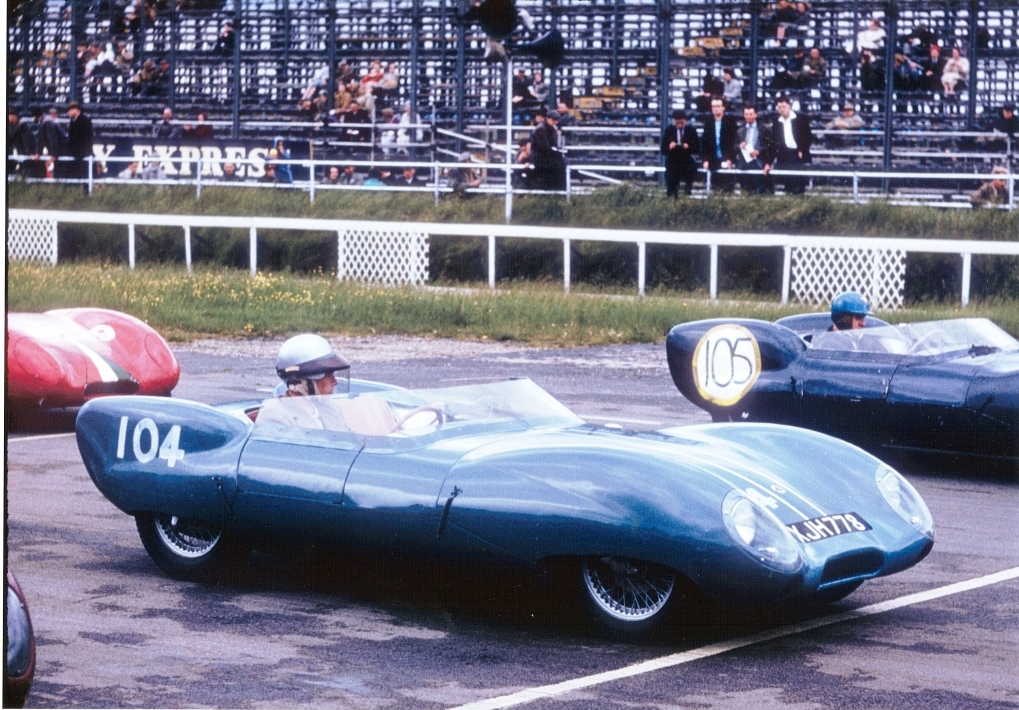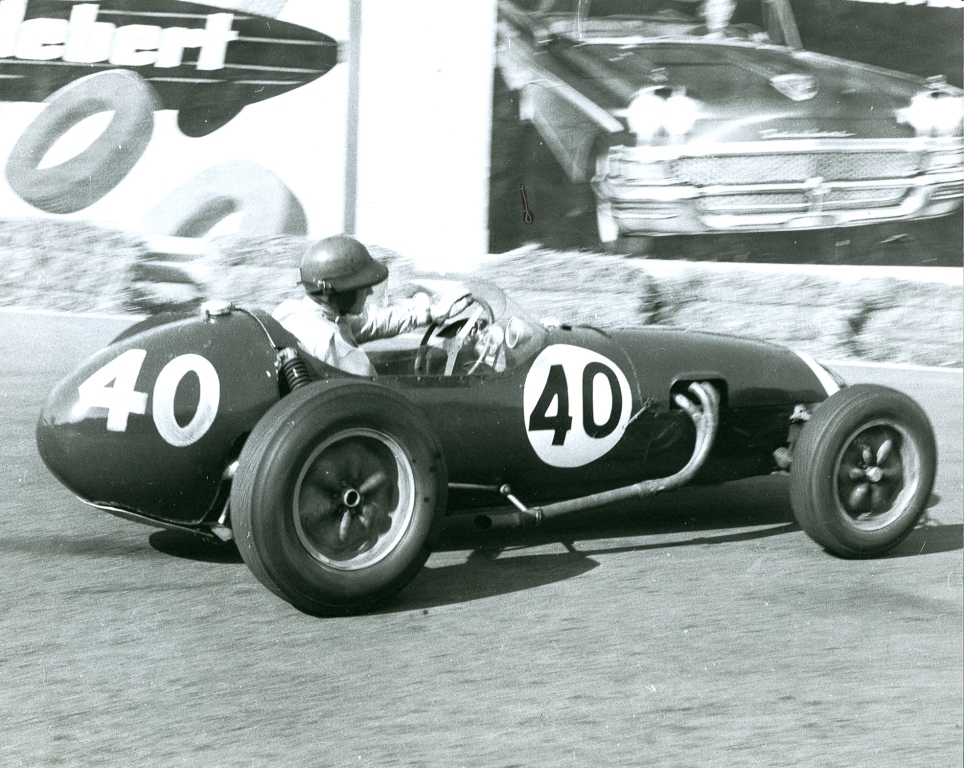 |
LOTUS SEVEN REGISTER |
the web site for the
Seven made by Lotus between 1957 and 1973
 |
LOTUS SEVEN REGISTER |
the web site for the
Seven made by Lotus between 1957 and 1973
| LOTUSES SPORTS-RACER FOR 1956 [The Eleven Series One]: The new Lotus car for 1956 was simply called the “Eleven” or ‘11’ as Chapman decided to drop the ‘Mark’ and Roman numerals as he felt that later it would only lead to confusion. The new design was a logical development of the Mark IX with smaller 1” and ¾” by 18 and 20 gauge tubing, swing axle front suspension with a lower pivot point to reduce understeer and a much lighter de Dion rear axle. In addition there was rack & pinion steering, Girling disc brakes on all four wheels, fully ducted air to the radiator and relocation of the 9 ½ gallon fuel tank to the left hand side of the chassis. For long distance competition another 11 gallon tank could be fitted on the right side. Compared with the old Mark IX, the Eleven had a much smoother and more compact body with the bonnet and tail cutting off more dramatically. The lower tail fins were less prominent and both front and rear wings partly hid the side view of the wheels. In addition many cars had the optional headrest cowl. Headlights were now behind perspex blisters and both front and rear body sections were hinged at either end for good access. |
 Lotus Eleven Club at Silverstone late 1950s.
Lotus Eleven Club at Silverstone late 1950s.
| THREE MODELS: The top of the range was the “LE MANS” model which was mainly for competition use. The drive train was 1098cc FWA or 1460cc FWB Coventry Climax engine, Austin A30 gearbox with Lotus close ratio gears and de Dion rear axle. Braking was with 9 ½” Girling discs and aluminium calipers, outboard at the front and inboard at the rear. Prices for the FWA model started at £1337-00. The second model was the “CLUB” which was as the name suggests for rather less serious competitive work. The FWA Coventry Climax engine was retained but a cheaper ‘live’ rear axle from the Nash Metropolitan was fitted. Braking was with drum brakes on all wheels. Additions like full width screen, wipers and hood meant that the Club could be used as daily transport if necessary. The price for this version was £1083-00. The basic model was the “SPORTS” which was powered by a Ford 100E 1172cc engine through the matching Ford 3-speed gearbox with Buckler “C” close ratio gears. In other respects it was similar to the Club model and really intended for road use only although a Sports model competed very successfully in the hands of Ian Walker. Priced at £872-00, few were infact sold. |
 Lotus Eleven sales brochure circa 1957.
Lotus Eleven sales brochure circa 1957.
| BACK TO LE MANS: Three Elevens were entered by Team Lotus for their second visit to the Sarthe circuit in 1956. New Le Mans regulations required wider chassis frames to facilitate proper two seater open cockpits and the compulsory fitting of full width screens. The drivers were Colin Chapman/Herbert Mackay Frazer in a FWB powered car and Cliff Allison/Keith Hall and Reg Bicknell/Peter Jopp in FWA cars. Despite heavy rain through the night, all the cars survived until the Sunday morning. The Chapman/Frazer car retired with big-end failure and the Allison/Hall car retired after hitting a large dog. However the Bicknell/Jopp car completed 2111.21 miles at an average speed of 87.97mph and was placed 7th on distance and 4th in the Index of Performance winning the 1100cc. category. This was a splendid victory for the surviving Lotus after a long battle against the Cooper in which one of the drivers had to stop to remove a newspaper, which had blown over the car’s radiator. IMPROVEMENTS FOR 1957 [The Eleven Series Two]: 1956 had established Lotus as a racecar manufacturer of international repute. Plans for the beginning of 1957 included a racecar for the new Formula Two, dubbed the Lotus Type 12 and an improved Eleven. The new Series Two Eleven featured double wishbone and coil spring front suspension and a stronger de Dion rear axle to cope with the newly available 1475cc twincam Climax FPF power unit. Lotus now offered a choice of four models: “Le Mans 150” with the FPF and de Dion axle, “Le Mans 85” with stage 2 FWA and de Dion axle, “Club 75” with FWA and Nash Metropolitan rear axle and “Sports 45” with Ford 100E 1172 side valve engine and Nash Metropolitan axle. SUCCESS AT LE MANS: 1957 was a particular successful year for the little car manufacturer from Hornsey, North London. There were five Elevens, three of which were works entries: A 744cc FWC driven by Cliff Allison/Keith Hall, a 1500cc FPF driven by Herbert Mackay Frazer/Jay Chamberlain (U.S. importer) and a 1100cc FWA driven by Peter Ashdown/Alan Stacey. The other two were 1100cc FWA private entries driven by local Frenchmen Hechard/Masson and Walshaw/Dalton. The 1500cc car of Frazer/Chamberlain dropped a valve in practice and was a non-starter so these drivers took over the 1100cc car of Ashdown/Stacey for the race. All the four Lotuses finished the race with the works car of Allison/Hall finishing 14th on distance after completing 2160.61 miles at an average speed of 90.03mph and winning the Index of Performance and the 750cc. Class. The Frazer/Chamberlain car with it’s larger engine capacity was placed 9th on distance after completing 2377.99 miles at an average speed of 99.09mph and was 2nd in the Index of Performance and first in the 1100cc. class. The two private entries were placed 13th and 16th on distance. In all there were some 270 of both Series One and Series Two examples built by the factory during the years 1956, 1957 and 1958. |
| FIRST SINGLE SEATER: In addition to the improved version of the Eleven, the start of 1957 also saw the first Lotus single seater formula car, the Type 12. Originally designed to compete under the new 1957 International Formula 2 regulations for unsupercharged 1500cc cars, work was well under way on the project by the end of 1956, infact the front engined prototype had been displayed at the Earls Court Motor Show earlier that year. Consisting of an aluminium clad spaceframe of aircraft quality tubing, double wishbone front suspension and initially a de Dion rear axle, the car was powered by the new twin overhead camshaft Coventry Climax FPF engine driven through a new Lotus 5-speed transaxle gearbox nicknamed the ‘Queerbox’ because of it’s continual problems. Braking was by Girling discs and aluminium calipers to all the wheels which were the new Lotus ‘wobbly-web’ cast magnesium alloy type of considerable strength and low weight. On finding that the handling was affected by the changing weight of the rear mounted fuel tank, a different type of suspension dubbed the Chapman Strut was used. Basically each of the rear corners were located by a coil spring damper unit (vertically), a single trailing arm (fore and aft) and a fixed length drive shaft (laterally). |
 Cliff Allison in the Lotus Twelve at the 1958
Belgium GP.
Cliff Allison in the Lotus Twelve at the 1958
Belgium GP.
| The Type 12 was entered in both Formula One and Formula Two between 1957 and 1959 using Coventry Climax FPF engines of various capacities. Not a match for the Climax engined Coopers of the day Colin Chapman’s first single seater was less than satisfactory or successful. Twelve of these cars were produced. Photographs by courtesy of:- Ferret Fotographics TEL: 01453-543243 Washington Photo TEL: 00 33 243-413583 Sources and further reading: Colin Chapman – The Man and his Cars by Jabby Crombac. (1986) Lotus – All the Cars by Anthony Pritchard (1990) The Lotus Book by William Taylor (1998) Lotus – The Historic Years by Graham Capel. JWW |
| [previous chapter] [next chapter] [back to menu] |